Talk of gender inequality in tech isn’t new—but the conversation has become louder, more urgent, and harder to ignore.
From the underrepresentation of women in software engineering to the ongoing lack of female executives at major tech firms, the gender gap shows up at nearly every level of the industry.
Add in pay disparities, barriers to advancement, and troubling attrition rates, and it’s clear this is more than a passing concern.
To really understand where things stand, it helps to look at the numbers.
In this article, we’ve compiled the most important women in tech stats to shed light on where progress is happening—and where the biggest challenges remain.
Let’s take a closer look:
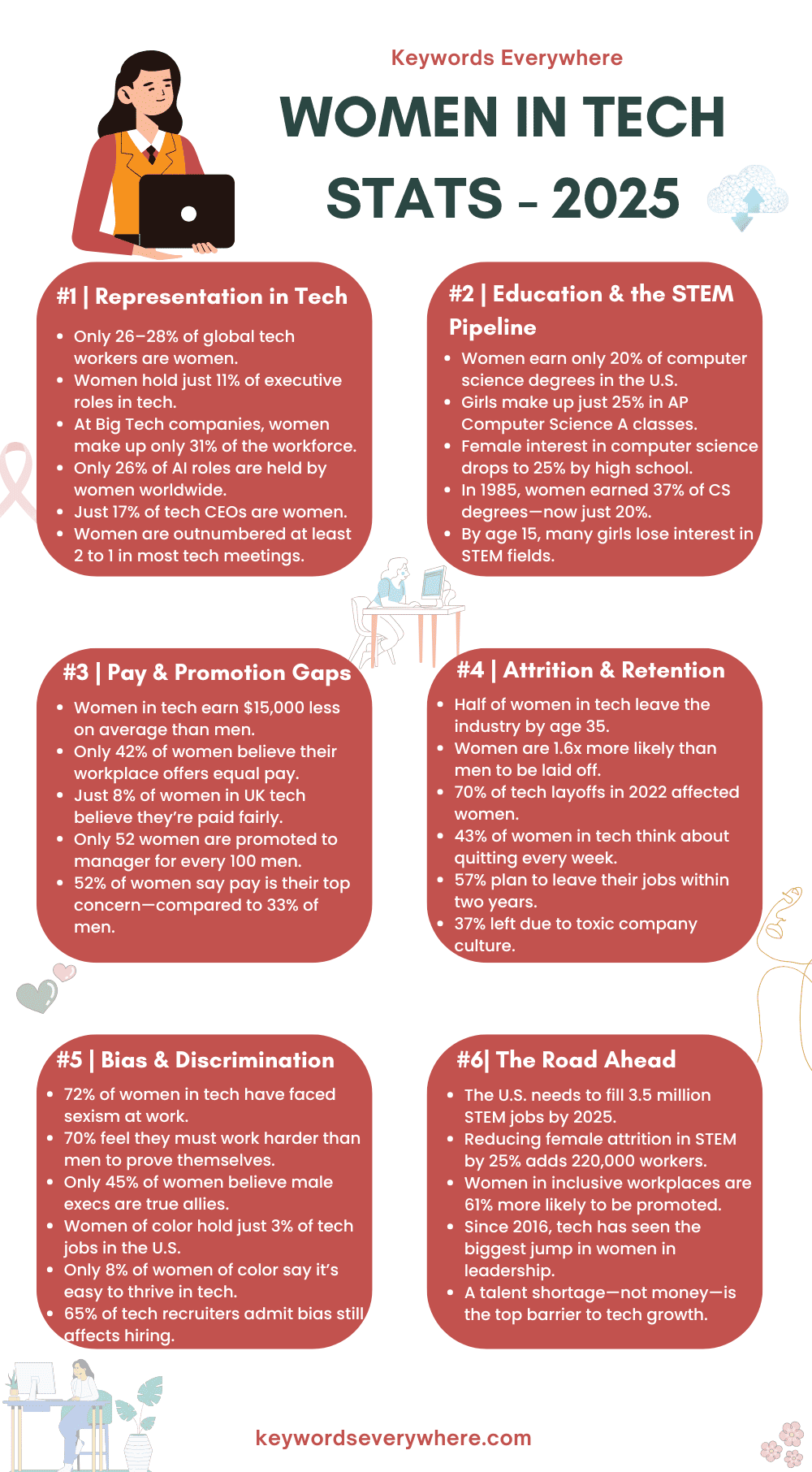
Top Women in Tech Stats
Every year, we hear more about the push for diversity in the tech world, but how much progress is being made—and are women getting a fair shot in the most powerful industry of our time?
While women now make up about 28% of the tech workforce in the U.S., that number hasn’t changed much in the past decade, and it’s even lower in roles like software engineering or data science.
So, what’s going on behind the headlines?
The following women in tech stats reveal the bigger picture we all need to see.
1. Even though women make up around 42% of the global workforce, only about 26–28% of people working in tech are women.
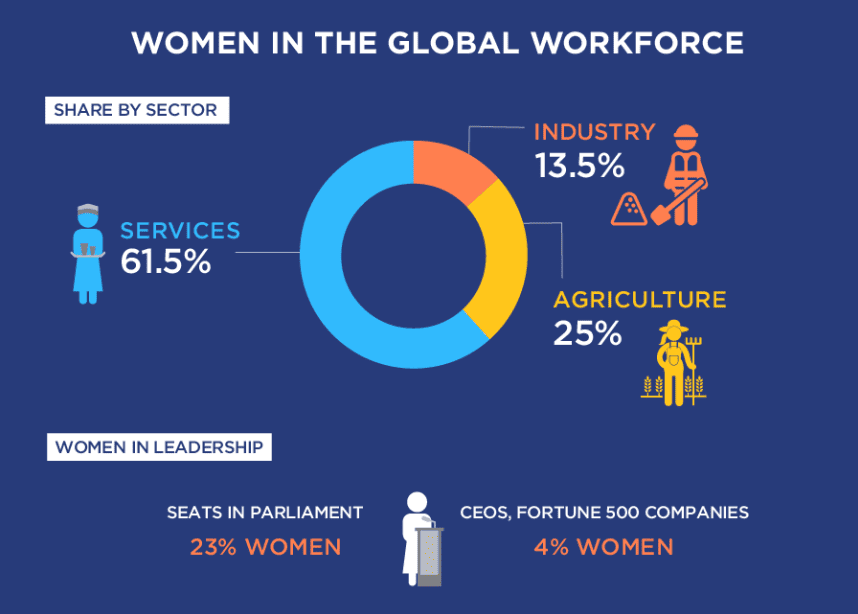
Women in the global workforce
2. By the time they turn 35, nearly half of all women who started out in tech have already left the field, often due to burnout, bias, or lack of growth opportunities.
3. Back in 1985, women earned 37% of computer science degrees, but today, that same number has dropped to just around 20%.
4. About 65% of tech recruiters say there’s still bias in the hiring process, and 66% of women working in tech say they don’t have a clear path to move up in their careers.
5. None of the major tech giants—Google, Apple, Facebook (Meta), Amazon, or Microsoft—have ever had a female CEO, and on average, only 31% of their employees are women.
6. On average, men in tech make about $15,000 more than women doing the same kind of work.
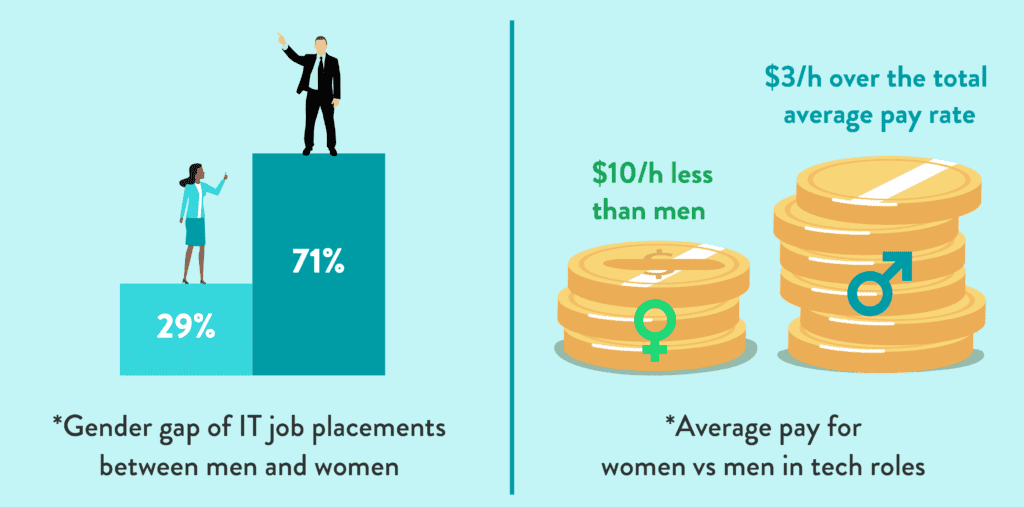
Average pay for women vs men in tech roles
7. A 2023 Deloitte study found that many women are leaving tech jobs because they don’t have enough flexibility or a healthy balance between work and life.
8. 72% of women say they’ve experienced a “bro culture” at work—where the environment feels male-dominated and not always welcoming or respectful.
9. While 77% of male executives believe they’re strong allies for women in tech, only 45% of women leaders actually feel the support is real.
Workforce Representation & Leadership Stats
It’s one thing to hire more women into tech jobs, but it’s another thing entirely to see them leading teams, setting direction, and having real influence within companies.
Despite efforts to improve diversity, only around 15% to 20% of tech leadership roles are held by women, and representation tends to shrink even more at the executive and board levels.
Why does the tech ladder seem harder to climb for women, and where are the gaps most visible?
Below are the women in tech stats that show where representation stands—and where it still falls short.
10. Only about 25% of people working in tech today are women, and when it comes to leadership, the numbers are even lower—just 11% of executive roles are held by women.
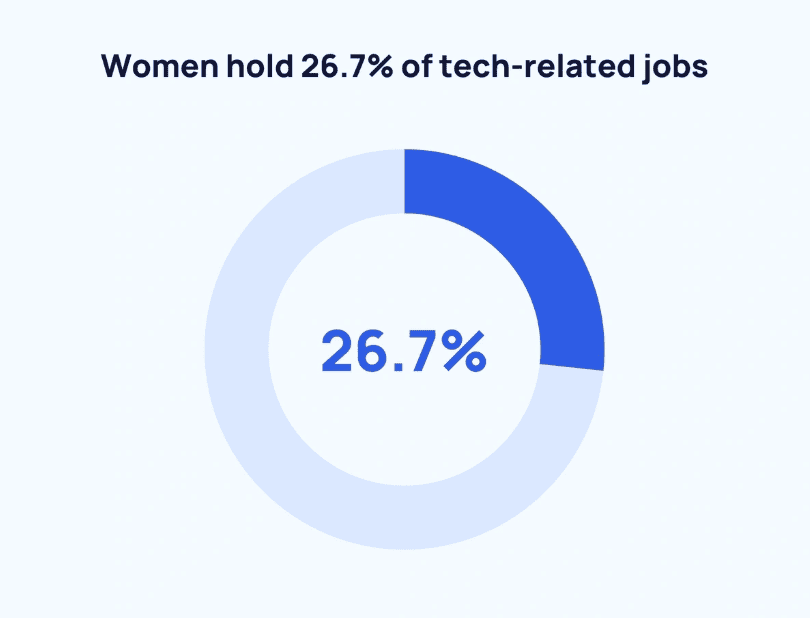
Women hold only about one-fourth tech-related jobs
11. Women make up just 26% of AI roles worldwide, and the numbers are worse in areas like cloud computing (15%) and data science (12%), where female representation is still far behind.
12. Across computer and math-related jobs, women hold around 28% of the positions, but in tech roles across European companies, that drops to just 22%.
13. In the UK, while 29% of tech workers identify as women or non-binary, only 20% of software engineers fall into that group, showing a gap in more technical roles.
14. In many tech companies, there are about three men for every woman, and that ratio climbs to four to one in technical roles; 72% of women say they’re regularly outnumbered by men by at least two to one in meetings.
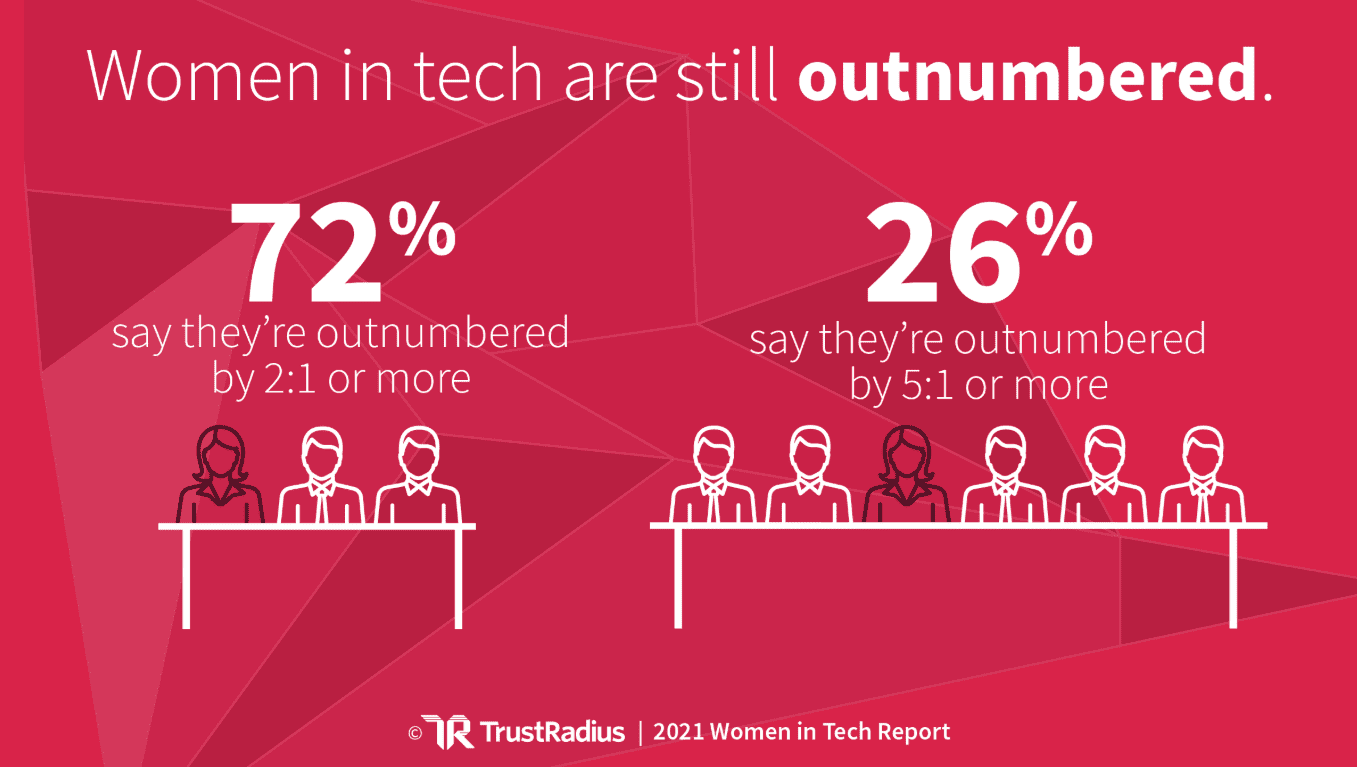
Women in tech are still outnumbered
15. Although women hold 35% of jobs across STEM fields overall, their presence in tech-specific domains like cloud and data remains among the lowest.
16. The largest U.S. tech companies average 33% women in their workforces, with numbers ranging from 29% at Microsoft to 45% at Amazon.
17. Only about 10–11% of executive or senior roles in tech are filled by women, and just 17% of tech CEOs are women; when it comes to CTOs, that number drops to a mere 8%.
18. While 25% of C-level roles in the U.S. are held by women, only 5% are women of color, revealing another layer to the representation gap.
19. Even at Big Tech companies like Google, which are often seen as progressive, women hold only 28% of leadership positions, showing the gap isn’t just in smaller firms.

Women’s representation in Big Tech
20. More than half of women in tech (53%) say it’s harder for women than men to get promoted into senior roles, especially at big tech companies.
Education, Training & the STEM Pipeline Stats
The journey into tech doesn’t start at the first job—it begins in classrooms, college programs, and coding boot camps that lay the groundwork for a tech career.
Yet many drop out of STEM paths before ever reaching the industry.
What’s turning them away from tech so early, and how can that pipeline be repaired?
The following women in tech stats reveal the challenges and drop-offs in education and training that continue to shape the industry.
21. In the U.S., only 20% of computer science degrees go to women, and the numbers are nearly the same in engineering, where women earn just 22% of undergrad degrees.
22. Back in 1995, women earned 29% of computer science degrees, but by 2018, that dropped to 18%—though recent data shows a slight climb back up to 20% today.
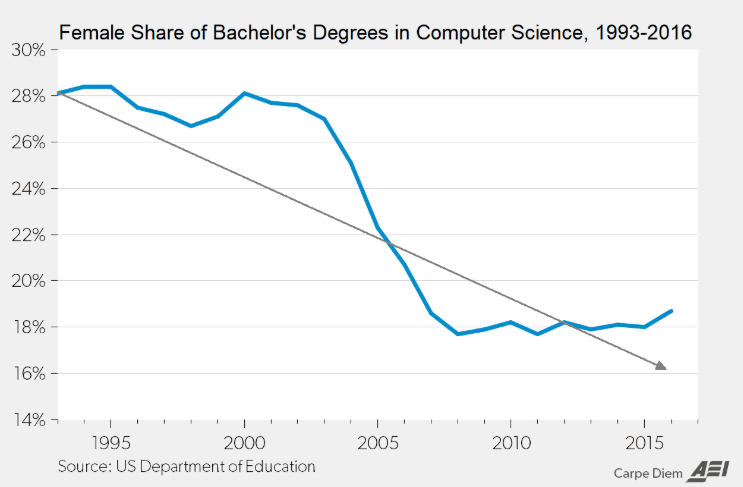
Declining female share of Computer Science degrees from 28% to 18%
23. Among women who studied computer science, 63% said they weren’t happy with the lack of gender balance in their classes, which can make the learning environment feel isolating.
24. In high school, girls make up 34% of students in AP Computer Science Principles courses, but that number drops to 25% in AP Computer Science A.
25. Harvey Mudd College is one success story—it raised the percentage of female computer science majors from 10% to 55% in just ten years.
26. A 2022 survey of students in grades 7–12 found that only 25% of girls were interested in learning computer science, compared to 50% of boys, pointing to a big interest gap that starts early.
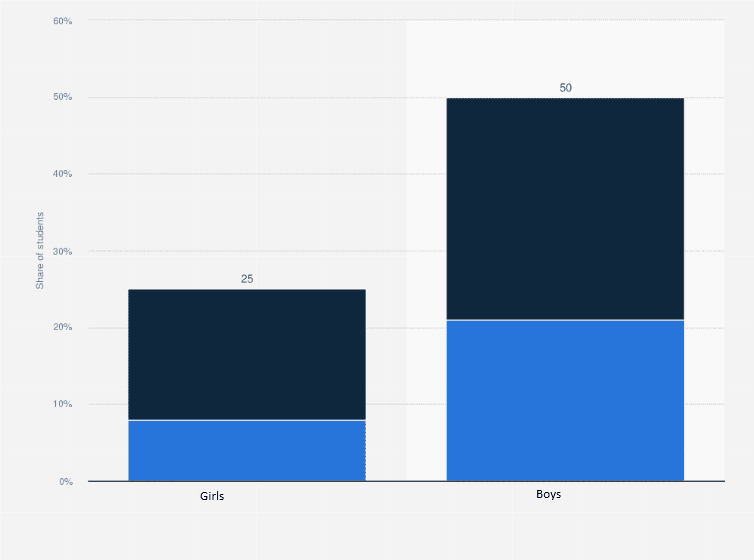
How interested students are in learning computer science by gender
27. Studies show that girls and boys exhibit equal interest in STEM around age 11; however, by age 15, many girls lose interest—often due to stereotypes and a shortage of visible role models in the field.
Pay, Promotion & Advancement Stats
It’s no secret that women in tech often earn less than their male peers, but the pay gap is just one part of the story.
Women are also promoted at slower rates, passed over for leadership roles, and often receive less visibility for their work—even when their performance is equal or better.
In fact, studies show that women in tech earn around 83 cents for every dollar a man makes, with the gap widening for women of color.
Here are the women in tech stats that reveal how money, promotions, and career growth aren’t always equal.
28. In the UK, just 8% of women in tech believe they’re being paid the same as men for doing the same job.
29. In the U.S., women working in tech earn about $99,000 a year, while men in similar roles average $114,000, meaning women make $15,000 less on average.
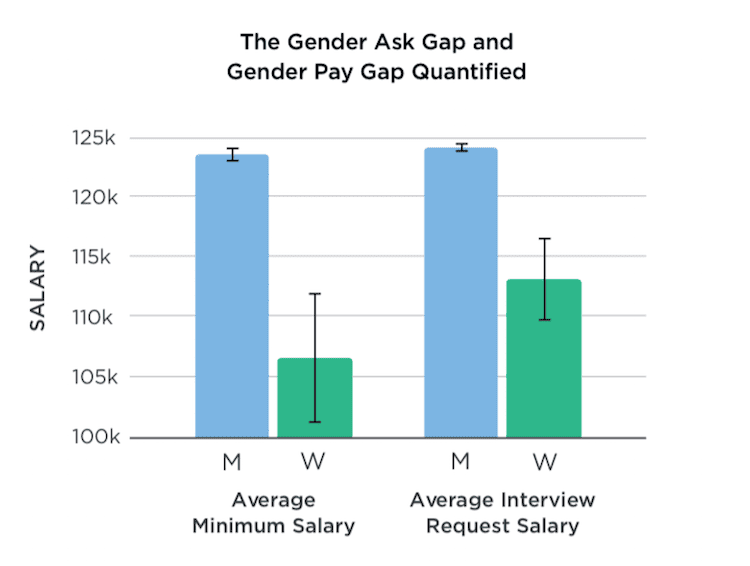
Gender ask gap and gender pay gap
30. Across Europe, women working in tech still earn about 26% less than men, proving the gender pay gap is not just a U.S. issue—it’s global.
31. When it comes to raises and bonuses, fewer women get them—only 52% of women reported getting a raise compared to 56% of men, and just 40% of women got bonuses versus 53% of men.
32. There’s a common belief that women care more about benefits or flexibility, but in reality, 52% of women say pay is their top priority—compared to only 33% of men.
33. While 75% of men believe their company offers equal pay, only 42% of women feel the same way, showing how differently the two groups see fairness in their workplaces.
34. A 2022 McKinsey report showed that for every 100 men promoted to manager in tech industry, only 52 women are promoted—and the number is even lower for women of color.
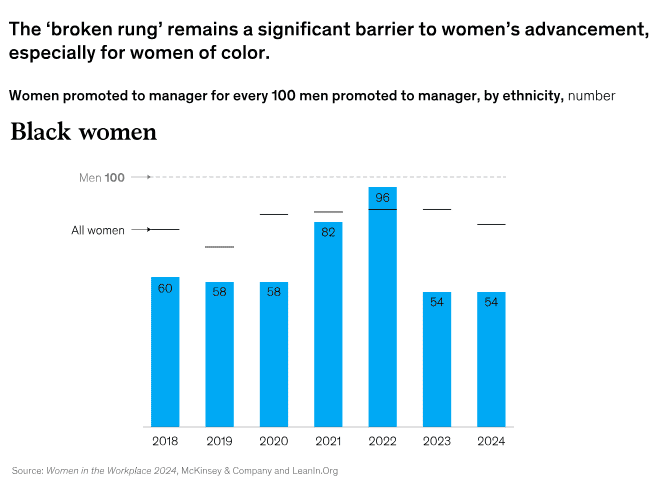
Women promoted to manager for every 100 men promoted to manager
35. Women working in inclusive environments are 61% more likely to reach management roles, and that number rises to 77% for women of color, according to Accenture.
36. Men also benefit from inclusive workplaces, with a 15% higher chance of being promoted to management when inclusion is part of the culture.
37. In tech hardware roles, only 32% of entry-level positions are held by women, and in software, it’s 43%—but the numbers drop as roles become more senior, falling to just 17% in hardware and 30% in software at the SVP level.
Attrition & Retention Stats
Why do so many women leave tech—and why do they leave faster than men?
The answer isn’t simple, but it often has to do with feeling unsupported, isolated, or even pushed out by workplace culture.
Research shows that women are more likely to quit tech jobs by mid-career compared to men, and many say they don’t see a future for themselves in the field.
Below are the women in tech stats that show what keeps women in tech—and what drives them away.
38. Women are 1.6 times more likely to be laid off than men in tech, often because they’re newer to the company or hold roles with less seniority.
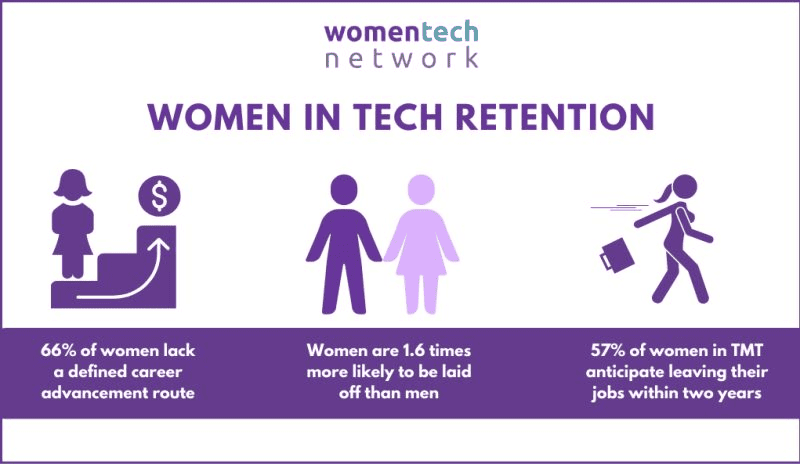
Women in tech retention
39. In the Technology, Media, and Telecom industries, 57% of women say they plan to leave their jobs within two years, with many pointing to poor work-life balance as the main reason.
40. During the major 2022 tech layoffs, women were hit hardest—nearly 70% of those laid off were women, according to a study of thousands of profiles by the WomenTech Network.
41. If current trends persist, the share of women in tech roles in Europe could drop to just 21% by 2027.
42. About 43% of women in tech say they think about quitting at least once a week.
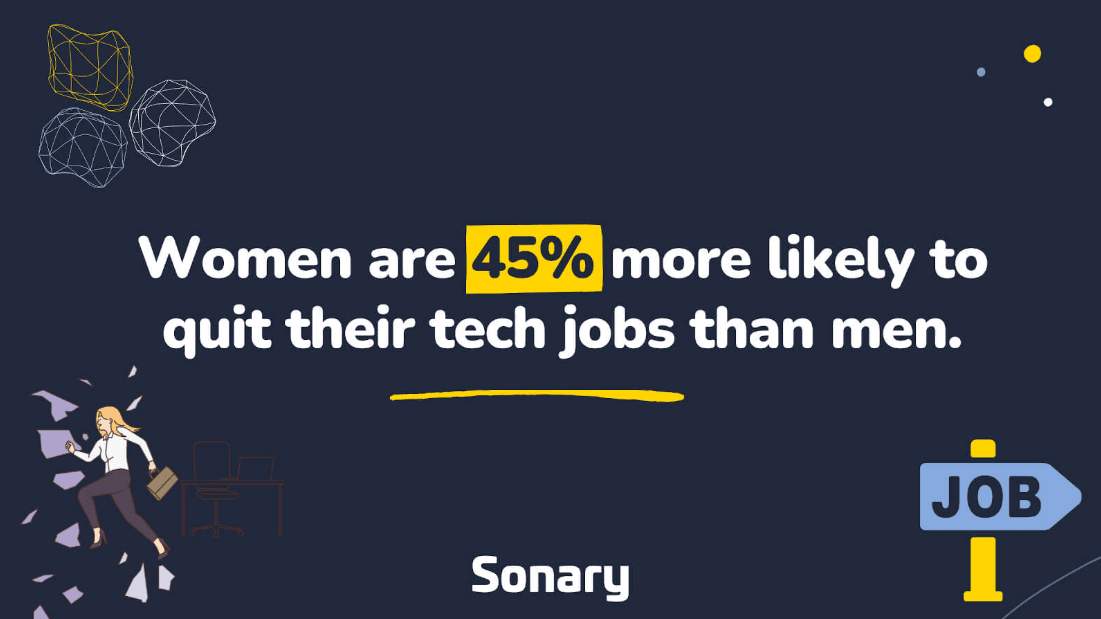
Women in tech are more likely to quit their jobs than men
43. More than half of women in tech leave the field by mid-career, which is more than twice the rate of men.
44. So why do women leave tech? A survey found that 37% left because of bad company culture, 28% because of limited chances to grow, and 27% for family-related reasons.
45. Overall, women in tech are about 45% more likely than men to leave the industry—and many are doing so well before they reach senior roles.
46. In fact, half of all women in tech have left by age 35, a number that shows just how early the drop-off happens.
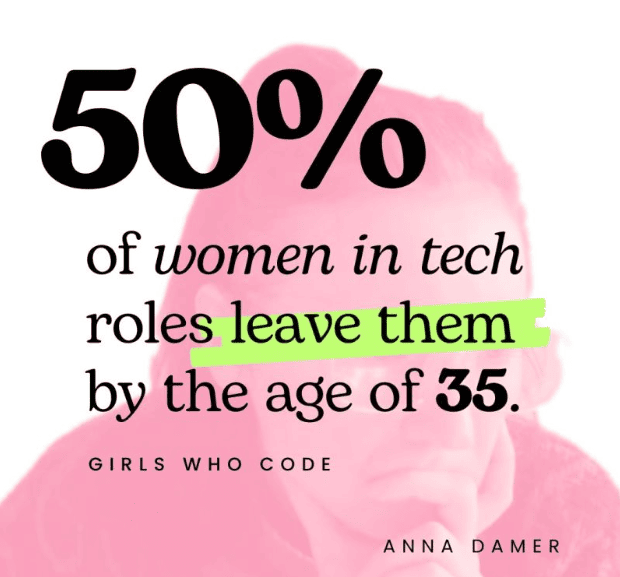
50% of women in tech leave their jobs by the age of 35
47. 9 out of 10 women who’ve left tech say they’d be open to coming back—if workplaces improve and offer better support, flexibility, and opportunities.
Barriers, Bias & Discrimination Stats
Even when women make it into tech, the path isn’t always smooth.
Many face subtle biases, unequal treatment, or outright discrimination that chips away at confidence and opportunity.
In fact, nearly 50% of women in tech say they’ve experienced some form of gender-based discrimination in the workplace.
The following women in tech stats reveal how bias continues to block progress and impact daily experiences.
48. Around 72% of women in tech say they’ve experienced some form of sexism at work, including things like sexist jokes (22%) or having their skills questioned (20%).
49. 70% of women in tech feel like they have to work harder than men just to prove themselves, simply because of their gender.
50. While 77% of male executives believe they’re strong allies for women at work, only 45% of female executives agree.
51. Women of color remain especially underrepresented in tech—though 27% of computing roles are held by women overall, only 3% are Black women, and 2% are Hispanic women.
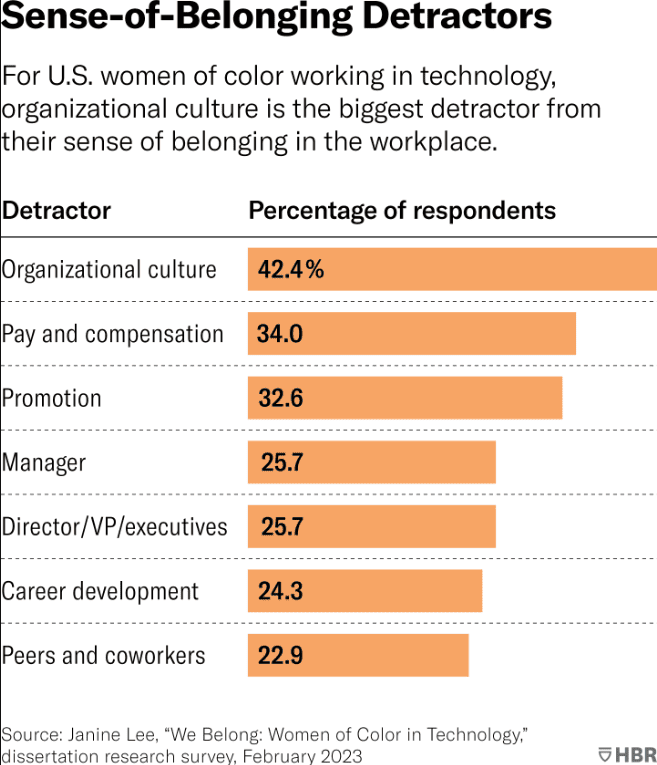
Sense-of-belonging detractors for US women of color working in tech
52. Out of all 390 women of color in tech surveyed, just 8% said it’s easy to thrive, compared to 21% of all women, revealing just how much harder the experience can be.
53. In less-inclusive workplaces, 62% of women of color say they’ve heard inappropriate comments or remarks—compared to just 14% in inclusive cultures.
54. LBT women in tech face similar challenges, with just 9% saying it’s easy to succeed in tech compared to 23% of non-LBT women.
55. However, in inclusive environments, 83% of LBT women say they love their jobs, and 85% say their workplace feels empowering—but in less-inclusive companies, those numbers drop to 35% and 20%.
56. LBT women in non-inclusive settings were also twice as likely to face inappropriate remarks or feel like they didn’t belong in tech at all.
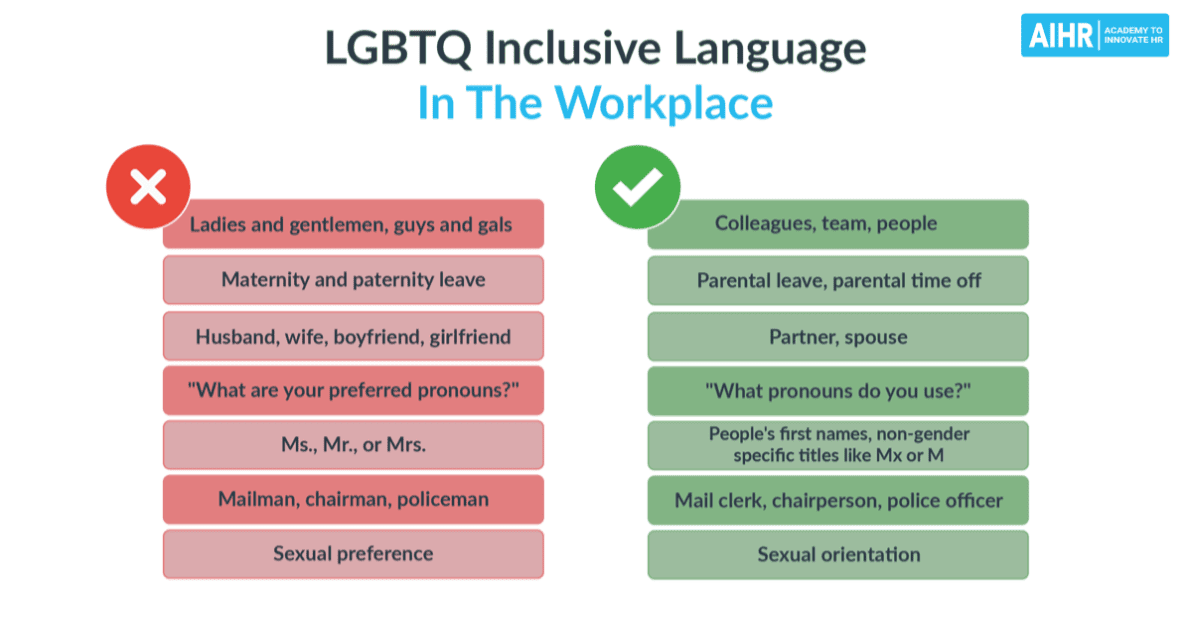
What’s LGBTQ inclusive language in the workplace
57. A huge 72% of women report a “bro culture” at work, where men dominate conversations, networking, and decision-making spaces.
58. 65% of tech recruiters admit that bias still exists in the hiring process, often keeping diverse candidates from getting fair chances.
59. When asked about career growth, 55% of women said their biggest barrier was that colleagues don’t fully trust their abilities, while 29% pointed to the lack of a clear path to advance.
Progress & the Road Ahead
Despite the setbacks, women in tech are still pushing forward—breaking barriers, starting companies, launching new programs, and leading the charge for a more inclusive industry.
But change isn’t happening fast enough, and the real question is: are we doing enough to build a future where women in tech don’t have to fight so hard to be seen and heard?
Here are the women in tech stats that reveal where things are improving—and what still needs work.
60. The Bureau of Labor Statistics indicates that jobs in computer science research will grow by 19% by 2026, but finding enough skilled workers to fill them is becoming more and more difficult.
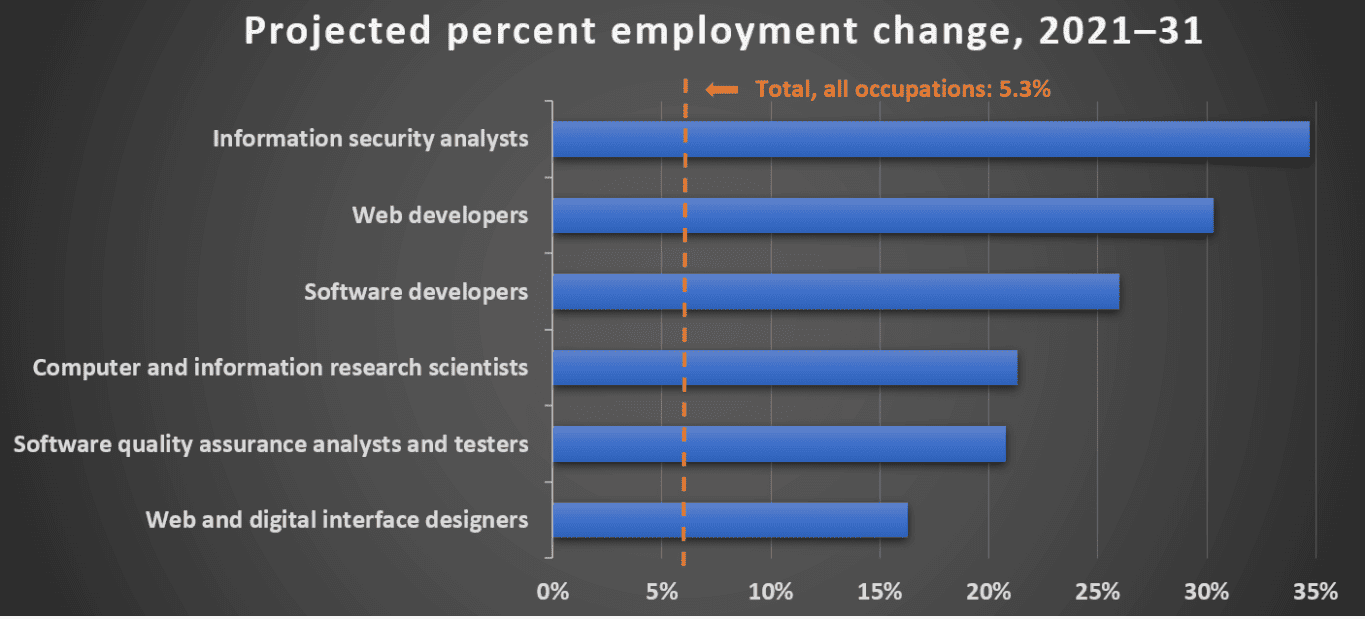
Projected percent employment change, 2021-31
61. According to IT leaders, the biggest barrier to using new technologies isn’t money or security—it’s the shortage of skilled talent, which has become a top concern across the industry.
62. By 2025, the U.S. will need to fill nearly 3.5 million STEM jobs, including over 1 million in computing—but experts warn that 2 million of these jobs could go unfilled due to a lack of qualified people.
63. If we could reduce how many women leave jobs in tech, engineering, and science by just 25%, it could add 220,000 more workers to the talent pipeline, helping close that gap.
64. Between 2016 and 2022, tech saw the biggest rise in hiring women into leadership roles, showing progress is possible when companies commit to change.
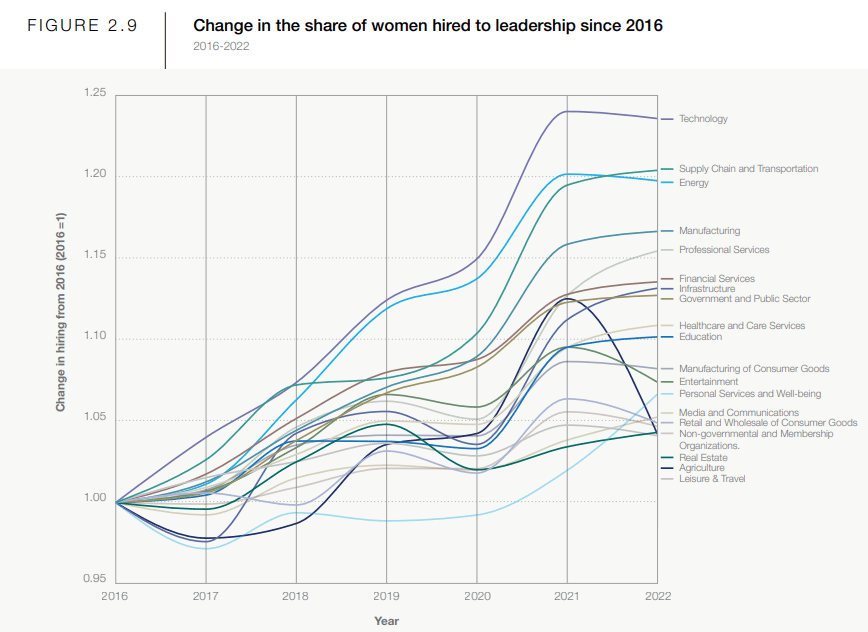
Change in the share of women hired to leadership since 2016
Conclusion
The current state of women in tech is a mix of slow progress and ongoing challenges. The numbers above reveal a landscape where women remain underrepresented, underpaid, and too often undervalued.
The issues go beyond statistics—they reflect deeper cultural and structural barriers that push many women out before they can reach their full potential.
Moving forward, real change will depend on more than just good intentions. It will require companies to rethink how they hire, promote, and support women at every stage of their careers.
It will take schools and training programs that empower girls early and workplaces that commit to creating inclusive environments where women not only stay—but thrive.


